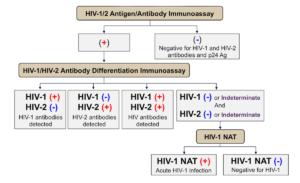HIV- Human immunodeficiency Virus
HIV stands for Human Immune Deficiency virus. This leads to AIDS, which is Acquired immunodeficiency syndrome. Detection of HIV infection is essential for diagnosis and monitoring of the infection. There are different types of diagnostic tools available that are based on the detection of HIV-specific antibodies, viral antigens or nucleic acid.
Your doctor may prescribe you these tests either as routine testing or if you have a history of contact with the virus through blood, saliva or sexual contact with the infected individual

Antibody Test:
An antibody test detects antibodies against HIV in your blood or oral secretions.
The only HIV self-test approved by the U.S. FDA is the most rapid antibody test.
In general, antibody tests can detect HIV sooner than other tests
Antigen/Antibody Test:
An antigen/antibody test detects both HIV antibodies and HIV antigens.
Antigen/antibody tests are suggested for testing done in laboratories.
Nucleic Acid Test (NAT):
A NAT detects the actual virus in your blood. Fig 1: HIV testing (2)
This test tells if a person has HIV and how much virus is in the blood, i.e., HIV viral load test.
A NAT can detect HIV sooner than any other type of test.
The ability of individual tests to detect HIV infection depends on the target(s) being detected when they can be expected to be present after infection, and the concentration of stable targets in test specimens, all of which are explained by the virologic and serologic events after infection. (1)
References:
(1) Hurt, C. B., Nelson, J., Hightow-Weidman, L. B., & Miller, W. C. (2017). Selecting an HIV Test: A Narrative Review for Clinicians and Researchers. Sexually transmitted diseases, 44(12), 739–746. https://doi.org/10.1097/OLQ.0000000000000719
(2) figure from https://cdn.hiv.uw.edu/doc/321-2/cdc-aphl-recommended-laboratory-testing-diagnosis-hiv-infection.jpg

